Test for Irina Anikeeva.
I love the design of this cardigan, with bold cabled sleeves and added pockets. The sleeve construction is also very interesting.
All is well explained and easy to follow. It’s not really difficult, but it’s good to have some experience in undoing a provisional cast on and seaming sleeves.
For a rustic look, I used a tweed yarn from stash.
This cardigan will be used a lot. It’s stylish and cozy at the same time, and fits me perfectly. I’m very happy with the final result, and would make it again!
Size 4
Test thread
Needles: ChiaoGoo interchangeables
3.75 mm as main needle used for upper body. Changed to 4.0 mm needle after body join under the armholes. (Also used for sleeve cables). 4 mm needles used for pockets.
3.5 mm as smaller needle (sleeve cuffs), but 3.75 mm for body ribbing (standard Bind-off with needle 4.0 mm). 3.5 mm needle was also used for frontbands, including Bind-off.
Provisional CO used was the crochet CO. Example
Yarn:
Viking of Norway Eco Highland Wool
Usdd total: 11.18 skeins = 1229.8 meters (1345.0 yards), 559 grams
My final cardigan measurements, washed and dry, size 4: Most measurements are near the pattern measurements, but the neck is larger (21 cm), while the hem circumference is smaller (118 cm).
- Neck width: 21 cm
- Neck to bottom: 55 cm (excluding neck ribbing)
- Armhole to bottom: 32.5 cm
- Total sleeve length: 38.5 cm (including cuff)
- Sleeve panel as in pattern
- Circumference at the hem: 118 cm (between size 3 and 4)
My final gauge differs on different body sections and is slightly different from the original.
- Upper back (needle 3.75 mm) unwashed: 19 sts and 28 rows (as washed in pattern).
- Upper fronts washed (needle 3.75 mm): 21 sts and 30 rows (tighter stitch and row gauge than original).
- Lower fronts (needle 4.0 mm) washed: 20 sts and 27 rows (slightly tighter stitch gauge, slightly looser row gauge).
Swatching and progress gauge:
Swatch with needle 3.75 mm, stockinette:
Unwashed: 20 sts/ 26 rnds
Washed, laid flat to dry and pinned without stretching - dry: 19 sts and 28 rows (as in pattern).
Calculations:
1 cm = 2,8 rows.
22 cm = 61,6 rows.
Back: last decrease made in row 54. Will knit 7 more rows = 61 rows from cast on edge, ending with a WS row.
After working the fronts down to the armhole, my gauge got tighter. I washed the upper cardigan to check the measurements before considering if I should go up to a 4 mm needle (I’m using a 3.75 mm needle per now).
Gauge while wet: 20 sts and 28 rows. (With the 232 body sts, a 20 st gauge would give 116 cm in body circumference, while 19 sts = 122 cm; a 6 cm difference.)
Back measured after washing/ dry under armhole is 58 x 2 = 116 cm.
Gauge dry after washing was 20 sts/ 30 rows, so I continued the body with needle 4.0 mm.
Body ribbing was worked with needle 3.75 mm.
I used a crochet provisional cast on (also see link above). Since the pattern starts on a WS row, it would probably have been better to start the provisional CO on the WS too. Because I turned the crochet CO to WS to work the starting row from here, I couldn’t unzip the cast on later, but had to unpick it stitch for stitch. No problems, but quite fiddly.
Cuff: I picked up stitches at a ratio of 2:3 (2 sts out of 3 rows).
Cuff ribbing: After working the 2 first rows, I continued with 35 more rows in established pattern = 15 cm ribbing.
The frontbands were worked before seaming the sleeves.
Pick up stitch count:
76 sts right front - 56 sts diagonal line up to neck - 32 neck sts- 56 sts diagonal line down from neck - 76 sts left front = 296 sts total.
Pockets: There were some changes for the pockets during this test. I suggested a decrease before the ribbing to avoid flaring, which the designer found a good idea.
Here is how I worked the first row after having finished chart rows 1-26:
Next row (RS) Decrease row:
k1,p1,k4,p2,k1,p4,k2,k2tog, k2,p4,k1,p2,k4,p1,k1.
The following WS row (former increase row): purl all sts.
For the ribbing, to get the knit sts placed above the slipped sts, I worked (RS row): k1, p1 to end, k1 (and similar on WS).
After the 2 first ribbing rows, I followed the instructions as for the original test version: “Repeat last 2 rows 2 more times, then work 1 RS row.”
I bound off in pattern on WS with ribbing needle.
Pocket placement: the pockets were placed above a 26 stitch ribbing after blocking. This means, there will be 6 less sts for the hem ribbing than for the bottom pocket edge (difference on top pocket ribbing is 5 sts). This difference is no problem though, because the stitch patterns (cables, ribbings) make the fabric act in different ways. I found it good to follow the pattern instructions, working the pockets seperately, block, and seam them to the body, to get them to lay flat.
I marked the pocket placement lines before seaming.
Alternative for working the pockets: If picking up live stitches for the pockets and start from there, I would pick up 6 less sts and increase 6 sts below the cables (2 sts below each of the three cables). Otherwise, the hem ribbing might tighten below the pockets.
Bind-off: I used a standard Bind-off for all parts, but a Tubular BO is mentioned as an alternative in pattern.
Skeins:
(1) 51 g. Used for swatch and reused (frogged, steamed and dried). Used up 14 cm from start of back (measured at the sides).
(2) 51 g, used up at a few rows before end of right front.
(3) 52 g, used up 3 cm from armhole.
(4) 51 g, used up 12.5 cm from armhole.
(5) 52 g, used up 22 cm from armhole.
(6) 52 g, used up 3 cm into body rib.
(7) 50 g, left after body hem: 39 g, used for 1st sleeve. Used up during 2nd chart repeat row 19.
(8) 51 g, left after 1st sleeve panel and join: 25 g (later used for cuff).
(9) 50 g, 2nd sleeve panel started with this skein, used up in 3rd sleeve chart repeat row 11.
(10) 51 g, continued with 2nd sleeve. Left after 2nd sleeve panel and join: 12 g unused (used to seam the sleeves. Left unused after both sleeves and the pockets are seamed: 10 g).
(11) 51 g, used for frontbands. 16 g left unused.
(12) 51 g, used for pockets. 28 g left unused at the end.
51+51+52+51+52+52+50+51+50+41+35+23= 559 g total.
Knitting time:
I didn’t track the knitting time used, but only for the sleeve charts: rows 1-40 took about 2 hours and 30 minutes to knit up (each repeat).
 Lysstreif >
Lysstreif >  notebook > projects > Annemarie Cardigan TEST
notebook > projects > Annemarie Cardigan TEST 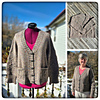
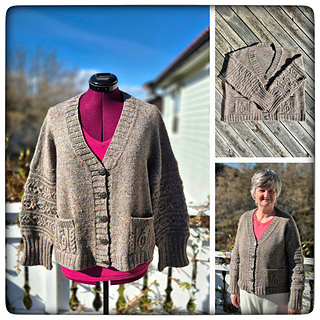
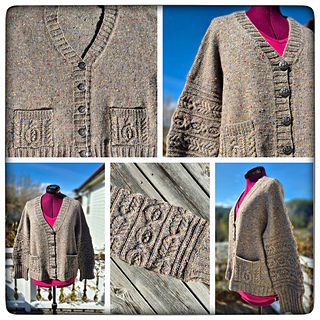
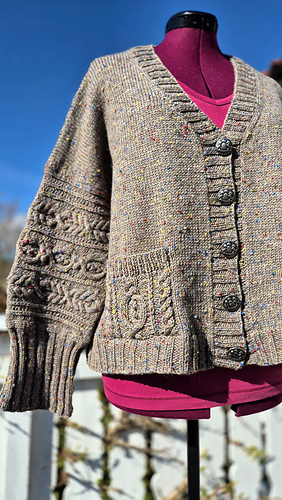

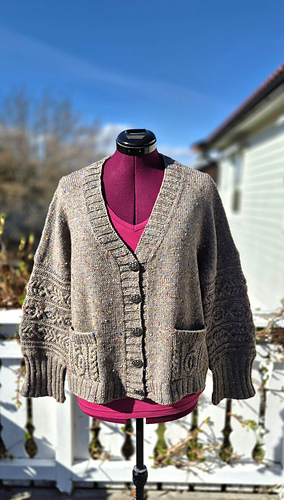
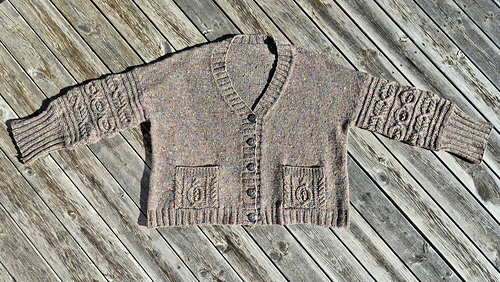

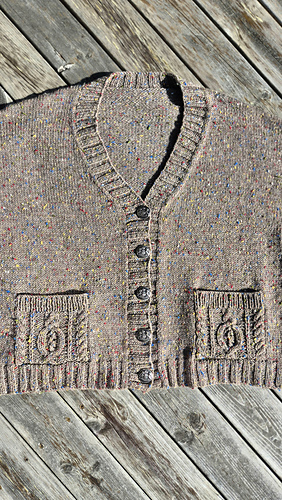

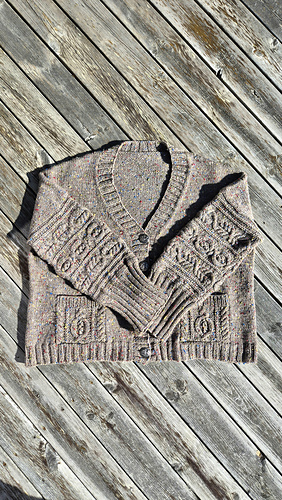
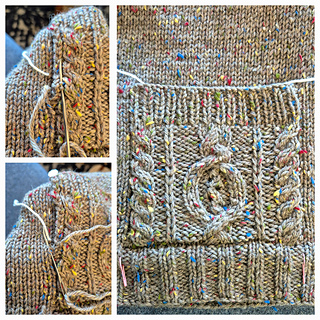
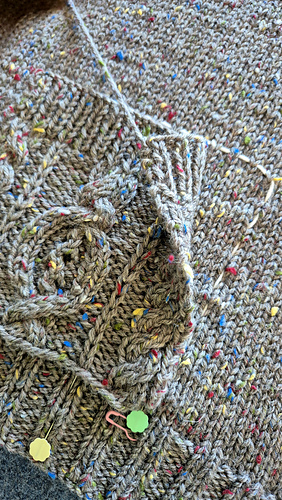
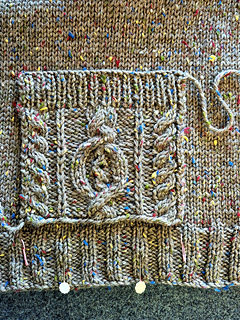

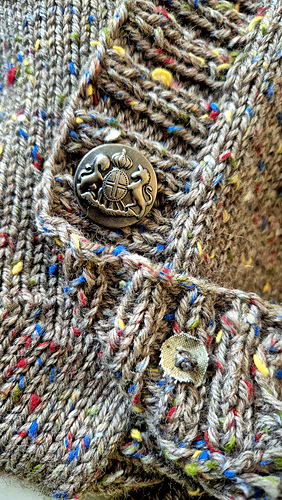

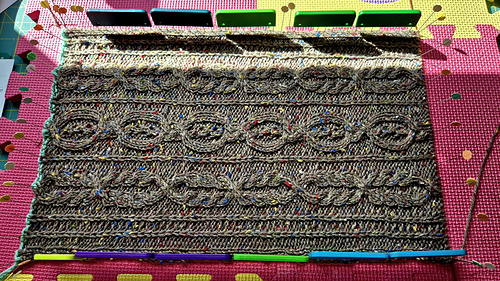

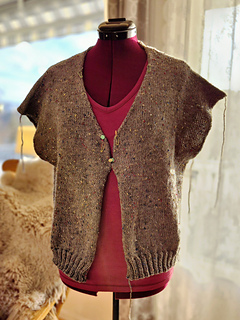

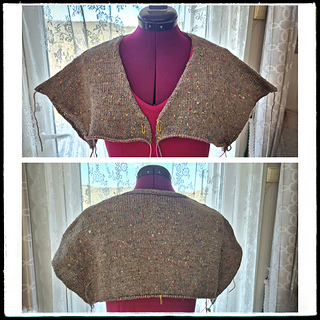
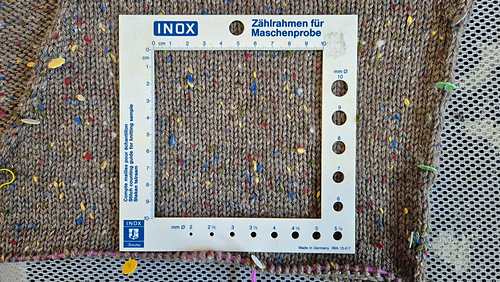

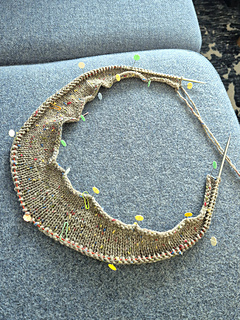


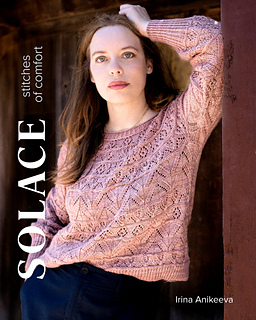
703 projects
stashed
465 times


 handspun
handspun queue
queue favorites
favorites friends
friends needles & hooks
needles & hooks library
library